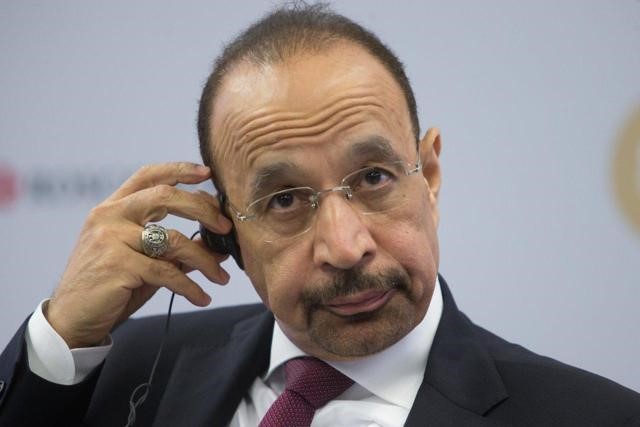
On July 24th, Saudi energy minister, Khalid Al-Falih, announced that Saudi Arabia would limit its exports to 6.6 million barrels a day (mmbd) in August. He noted that other producers were still exporting larger volumes of oil than their production cuts imply.
“We are not doing this to allow other countries to free ride and undercut the agreement by overproducing,” said Mr. Al-Falih, reflecting a high level of frustration. Observers described Mr. Al-Fahil as “very nervous” over the weekend.

Saudi Energy Minister Khalid Al-Falih. PHOTO: IGOR RUSSAK/ZUMA PRESS
I believe he sensed or was advised that oil prices may drop precipitously if OPEC only reported continued-high compliance. Last Friday, John Kilduff had said this was a “make or break” meeting, and “that if nothing comes out of this meeting, the cartel and Russia will be punished mightily.”
The 2017 Saudi national budget assumes an average oil price of just below $53/b, which Al-Falih had described in December as “conservative.” But even that price yields another large budget deficit for 2017. And so the Kingdom faces the dilemma of experiencing an even-larger budget deficit with prices in the $40s (or lower) v. trying to get prices in the $50s, but giving American shale oil a new opportunity to hedge production for 2018, thereby supporting production increases for another year. (A recent report by the Energy Dept. estimates that U.S. oil production will rise by 900,000 b/d from June 2017 through December 2018.)
My interpretation of the above is that he felt backed-into a corner to do something Monday. Furthermore, he obviously was unable to convince other producers to join-in. (UAE and Kuwait have subsequently announced additional cuts, though they had not abided by the full November cuts, and so their statements lack credibility.)
Following the May OPEC meeting, the public position of KSA, Russia, and OPEC has been that no changes would be made to the agreement because it was too early to assess the market impact. The Russian minister was also quoted as saying that they should not signal any doubts about the future effectiveness of the cuts to re-balance global inventories.
In addition, ever since the OPEC and Russian meeting in February 2016, the Saudi position has remained that the cuts would have to be borne by OPEC and non-OPEC producers alike. And so this unilateral decision to reduce exports for August, I believe, represents a desperation measure, if it is real.
To that point, an important point to consider is the tanker nomination process used by Aramco. Based on the information, nominations are normally finalized by the 10th day of the prior month. And in fact, nominations for August had been published in this report dated July 12th. The headline is that Aramco will meet the full August requirements of its customers in India, southeast Asia and its four customers in North Asia.
The report also stated, “For August, ‘there is no (supply) cut’ even for heavier grades such as Arab Medium and Heavy crude to South Asian customers… in the first half this year, Saudi Aramco cut output of cheaper heavy crude to meet its OPEC quota.”
Assuming Saudi cuts its exports as announced, and maintains full allocations to Asia, its largest market, it would have to cut deeper to European and U.S. destinations. It may have already intended to cut exports to its Motiva refinery in Corpus Christie, Texas, due to that refinery going into maintenance in the September/October timeframe. So Al-Falih may have used that fact as a talking point, just as he had previously masqueraded the seasonal decline in output as a cut.
Another possibility is that its nominations for August dropped for lack of demand due to higher world production. Earlier in July, India bought its first-ever U.S. crude and its refiners reportedly plan to buy more.
Conclusions
I believe that the announcement Monday was an act of desperation rather than of strength. And I have some doubts it will be fulfilled, given the tanker nomination process, or that it is a talking point because Aramco had planned to reduce exports to its U.S. refinery. Furthermore, he did not mention that it would be continued beyond August.
While it did affect sentiment this week, it will have a very limited impact on global inventories. The 6.6 million barrel per day figure is 324,000 b/d lower than May and 705,000 b/d lower than August 2016. (KSA had agreed to cut production by 486,000 b/d from October, and so this increase is not large.) The market impact is about 10 million barrels for one month.
If sentiment carries oil prices into the $50s, it will provide shale oil an opportunity to hedge more production for 2018, creating more headaches for KSA. The maximum sustainable price for the foreseeable future is in the $40s, assuming Saudi cuts further as world oil production rises. This scenario guarantees more red ink in Saudi budgets since its budgetary break-even is far above the $40s. Finally, with oil prices in the $40s, the market valuation for an Aramco IPO would be much lower than they are hoping.
Check back to see my next post!
Best,
Robert Boslego
INO.com Contributor - Energies
Disclosure: This contributor does not own any stocks mentioned in this article. This article is the opinion of the contributor themselves. The above is a matter of opinion provided for general information purposes only and is not intended as investment advice. This contributor is not receiving compensation (other than from INO.com) for their opinion.

The control by countries of oil production assures that we will continue to screw ourselves. Supply and demand has little to do with it. Publicly traded shale producers are playing the futures market, not counting on higher prices. All of their numbers are suspect, as are virtually all government numbers.